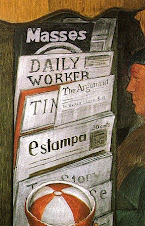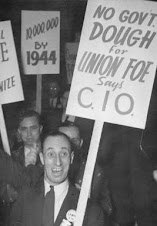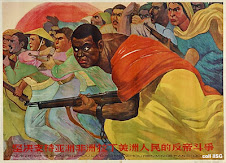By Caleb T. Maupin
In the modern world, two great hostile camps exist.
In the first camp lies the richest of the rich. They are the
owners of the overwhelming majority of all the banks, factories, giant stores, military production, oil
wells, natural gas, and all other economic power in the world. They own as
their private property not just all these things, but the governments of most
of the world which move at their every command. The western capitalists, or the
“1%”, make up this first camp of power in the modern world.
In the second camp, lies the rest of us. Those of us who
sell our labor power in order to survive: the working class. The people of
colonized world, no matter what their occupation are also in this second camp.
The peoples of Africa, Asia, the Middle East, and Latin America struggling
against imperialism and foreign domination, along with the global working class
make up the second camp, the 99%; the contradiction to Wall Street power. This
second camp is the overwhelming majority of all humanity.
The first camp has entrenched itself as the ruling class
over the last 500 years, vanquishing feudalism and replacing it with high tech
exploitation on a global scale. It has itself protected with propagandistic media,
military power and brute force, and all other means of establishing itself as a
force to be reckoned with.
The second camp is now in the process of entrenching and
cementing itself, as it rises in battle with the first camp, and take its place
at the helm of the world. The rising Bolivarian movements in Latin America, the
unified struggle against Zionism and U.S. imperialism in the middle east, the
alliance of China with the people of Africa; on a global scale this represents
the solidification of the global 99% in their opposition, to the 1%.
Within the borders of the U.S., the 99% is also solidifying
itself and asserting its power. The 2006 uprising of immigrant workers, the huge
outpourings against police brutality and racism, the struggle to defend public
sector unions, and the eruption of Occupy Wall Street signify the second camp,
the rising power of the workers and oppressed of the world.
The Dying Middle
Strata
However as this struggle boils on a global scale between the
global 1% and 99%, there is one sector that is doomed. No matter what force is
triumphant, whether the global capitalists, or the workers and colonized
peoples, this small strata is doomed.
This is the “middle class”, the “petty bourgeoisie.” It is
the indy artist or musician. It is the small shopkeeper. It is the owners of
the small “family owned farms.” It is the well known intellectuals and
academics. It is doctors and lawyers with their own practice, and no regular
employer.
It is those within the western capitalist countries who are
not workers, but do not find themselves within the global 1% of wealth power.
They “have their own” in a sense, with no regular employer renting them out
each day, but they will never be among the ranks of Warren Buffet or Bill
Gates. They “have their own” but it is just a small corner. It is a little bit
of security, a little bit of freedom, and some economic priviledge.
But this is slipping away. The global 1% is destroying them.
Wal-Mart is destroying every family owned hardware store. Major record labels,
internet self-publishing firms, all of them are rendering “independent artists”
out of existence. Agribusiness is turning the family farmer into a mere hired
laborer.
Doctors, the once hailed “professionals” are now mere hired
employees of big healthcare firms. Academic jobs are highly competitive, and
highly stifling. Professors are no longer free independent thinkers who
“profess” knowledge to the younger generation, but cogs in an academic machine
that brings in billions to the student loan sharks of Wall Street.
However, if the global 99% are victorious, this will not
save the middle class. In a socialist society, just as in modern capitalism, these
professionals and “independents” will not be able to “do their own thing.”
Decisions in the field of economics will be decided democratically and
equitably, but they will not be “laissez-faire.” Doctors will be sent where
society needs them. Art, media, and education will be subject to popular
criticism, input, and regulation. Big box stores will remain, but under popular
democratic control, with prices, hours, and all else regulated by the workers
and the community.
The future holds collectivism. It will be either the
collective obedience to wishes of a small, and shrinking capitalist class in
its drive for profits, or collective socialist decision-making and democracy
among the overwhelming majority of humanity.
No matter which side is victorious, the petty bourgeoisie
will perish. So, as they look to the future, they see misery. As artists often
find themselves among the ranks of petty bourgeoisie, this hopelessness and
fatalism is reflected in art.
“Hunger Games,”
Another Dystopia
George Orwell, expressed the fatalism of his class in his
novel 1984. He described the future
as “a boot stomping on a human face.” He spoke of a world where “independent
thinkers” will not be able to proclaim “2+2=4.”
Though Orwell was a social-democrat, who also associated
himself with Anarchism and other left-leaning petty bourgeois movements, his dark
vision of the future was no different than Ayn Rand.
Rand’s Anthem and Orwell’s 1984, have the same bleak view of the future. They are not
opposites by any means, but mirror images of each other. They fear nothing but
the future and the inevitable collectivism of it.
Petty bourgeois fatalism preaches against all collectivism
with the same repulsion. They view KKK lynch mobs and anti-racist rallies with
the same level of repugnance. Both show conformity, coordination of efforts,
and subordination of the individual to the needs of a group. The fact that two
such mobilizations serve a totally different social purpose is meaningless in
such a mindset.
“Hunger Games”
is another dystopian fantasy of the petty bourgeois variety.
The very premise of it is in some ways sickening. It is set
in a future United States, 70+ years after a failed revolt of starving people.
Why not make a film depicting such a revolt? Better yet,
depicting a revolt of the starving against the 1% that leads to victory. This
is a “Hunger Game” that would be very relevant in the age of capitalist decay.
Such a film would reflect on the Occupy Wall Street events, the Black
Liberation struggle, and all the rising movements across the world.
However, Hunger Games
starts with the premise, before the first lines of dialogue are uttered, that
such a revolt is doomed to failure.
The country created in the aftermath of the revolt is one
with a very small population, in which there is mass poverty. In order to
remind the public of the mistake of the failed revolt, some 70+ years ago, a
high tech gladiatorial show of sorts is carried out each year, where youths
fight each other to the death.
Yes, “the mob”, descendants of those who took part in the
revolt, now joyfully watch in public spectacles of death and violence of their
own peers. One character even
bemoans this fact saying “If we just stopped watching it would be over.”
The message is that the people in their millions, the true
makers of history, are a worthless mob of easily led sheep. They are oppressed,
but they are responsible for their oppression as much as the oppressors
themselves. “Conformity” is the films villain, not oppressive institutions and
systems.
And the Heroes?
So, with the masses of people in their millions as the
villians, who is the hero?
How many times before have we seen this in modern, popular
art? Harry Potter was “the boy who lived.” Slumdog
Millionaire won out on a TV game show. Superman is the orphaned child of
space aliens.
The heroes are never ordinary people who accomplish great
achievements, or engage in heroic actions.
No, the heroes are always “different”, they are always
“special”, they are somehow “chosen.”
Hunger Games is
not different. The heroin is “chosen” to do battle in an arena. She is
“special”, and “isolated.” Of course, the ordinary working class people she
grew up around don’t understand her, and victimize her, hating her for her
greatness.
While the feminist implications of female battle hero are by
all means progressive in our misogynist society, the character is still highly problematic.
The early scenes of the film border on grotesque in the level of tragedy. The
level of suffering the protagonist is forced to endure is repulsive and over
the top.
Other aspects of the film are equally confusing and
senseless as they reflect the alienation of the petty bourgeois from all
humanity.
Though only one of the combatants in the “Hunger Games” can
be victorious, and all others must die, somehow certain combatants band
together, and begin traveling as a group, working together, hunting down the
protagonist.
Despite it being irrational somehow “the mob” of Randian and
Orwellian nightmares finds its way into the climatic moments of the film, as a
conspiracy is formed to destroy the protagonist. This is odd as those
conspiring with each other against the protagonist, are expected to kill each
other.
Why do they conspire against the protagonist? What rational
sense does this make? They are all equally doomed.
They do it because she is “the chosen one”, she is the “great
individual”, and the world, the mob, is lined up against her. This petty
bourgeois paranoid fantasy has no rational way of fitting into the constructed
narrative, yet it still manifests itself.
The Revolution Is Not
A Game
The heroin of Hunger
Games by successfully “giving hope” to her district is seen as a potential
liberator of the suffering people of this future world. A “special person”, a
“chosen one” is seen as potentially achieving what a revolt of millions did
not?
The hope for the suffering people of this world is not that
someone will randomly chosen to become famous, and expose oppression with their
fame. If this were true, the likes of Paul Robeson, John Steinbeck, Lillian
Hellman, Susan Sarandon, Danny Glover and Jane Fonda would have rescued it long
ago.
The masses in their millions are the makers of history.
There will be no “condescending saviors” who win freedom for the people.
Only a movement of millions of people, coordinating their
efforts, empowering eachother, and eventually removing the small elite that
rules can point the way forward. Yes, individuals will play a role in such a
movement, and prove their exceptional qualities in the process, but they will
do it by their ability to put millions into motion, shaping the course of the
true makers of history.
A vanguard is just a small part of a larger army, and in
isolation, it is weak and worthless.
Socialism and the
Individual
While the rugged individualism of the petty bourgeoisie and
its self-isolating hero fantasies will perish in the flames of worldwide
socialist revolution, individuals will not perish.
The Soviet Union was filled with artists, writers,
musicians, and theater. Cuba today brings music into the education of every
child’s life, in a manner far beyond what any capitalist country has done.
Socialism produced the many well known scientists who
conquered the heavens with Sputnik. Socialism brought us the films of Sergei
Eisenstein. Socialism brought us epic breakthroughs in Ballet and Orchestral
music.
China’s cultural revolution brought films, theater troops,
and art to millions of people.
Socialism as it existed in the former USSR, and currently in
Cuba and People’s Korea has brought us many great individuals, who have
flourished due to collectivism. Collectivism empowers and unleashes the
individual to do far more than is possible in a state of isolation and
competition.
However, these great individuals were great because they
showed selflessness, devotion, and courage in their service of the collective.
They were not self-serving sociopaths like John Galt, or angsty egotists like Winston
Smith.
The heroes of the Socialist future are the like of John Q,
Tom Joad, and Jimmy Higgins. They are the selfless female liberation fighters
portrayed in “The White Haired Girl”, and in “Red Detachment of Women.” They
are unlikely tragic characters like the whistle-blowing Marine in Brian De
Palma’s classic Redacted. They are
the unknown masked freedom fighter in “V for Vendetta.”
These are the individuals hailed in Socialist art, art that
fights for freedom for the 99%, against the 1%.
Our movie does not end with an explosion, or the vanquishing
of a hated foe. No, the taking of power and the defeating of the 1% is the
beginning of the epic masterpiece of human history, when we rise as one and
continue to the line of march to stateless, classless Communism.












































No comments:
Post a Comment